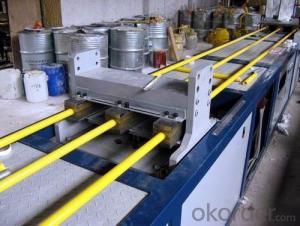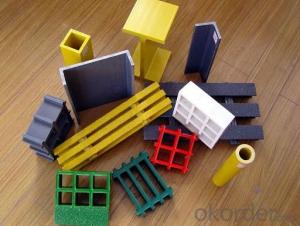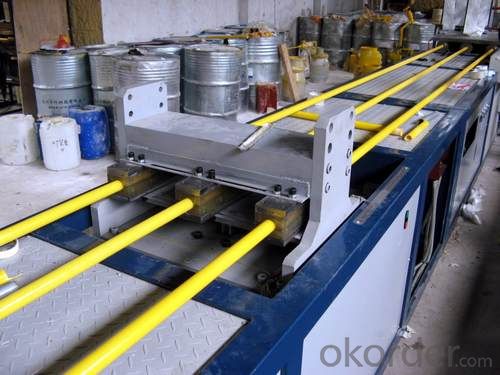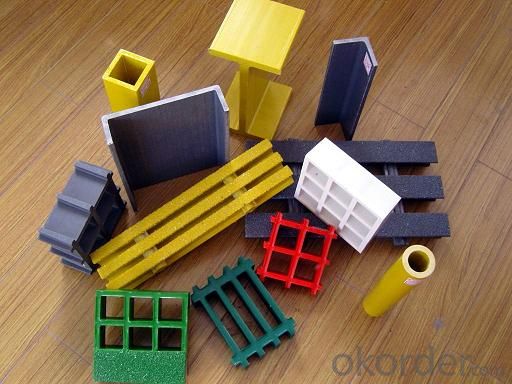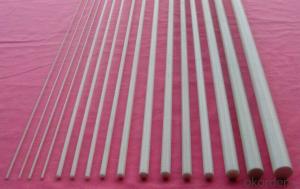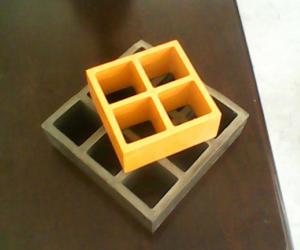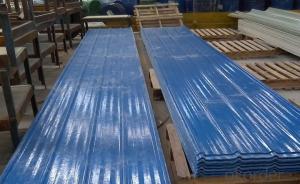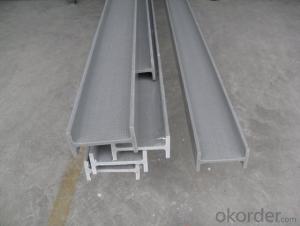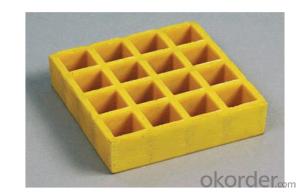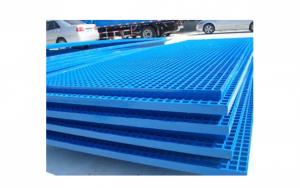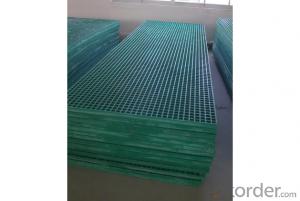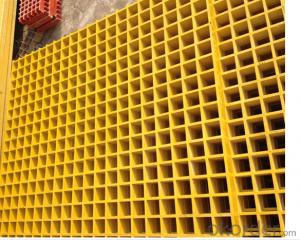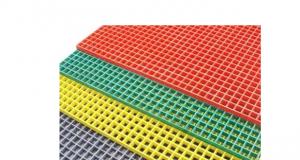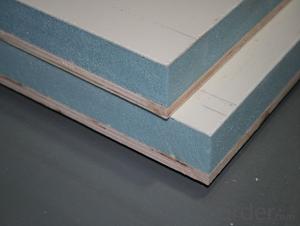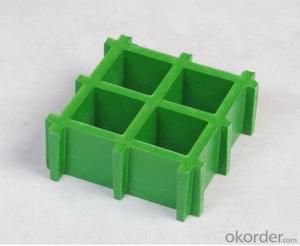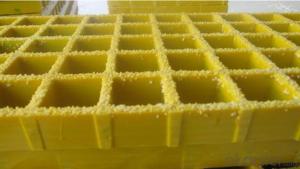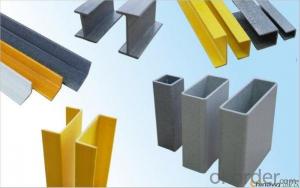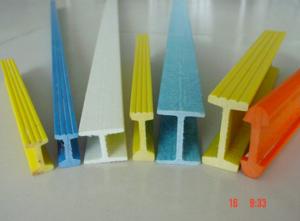FRP Pultrusion Profiles - Fiberglass Gratings
- Loading Port:
- Shanghai
- Payment Terms:
- TT OR LC
- Min Order Qty:
- 50 m
- Supply Capability:
- 80000 m/month
OKorder Service Pledge
OKorder Financial Service
You Might Also Like
Specification
Product Description
Pultrusion profile is a kind of compound materials which is formed by taking fiberglass as the reinforced material, and taking thermosetting resin as base, the fiberglass continuous roving enable the product to have the extremely high longitudinal strength, the fiberglass mat (continuous strand mat, knitted mat and so on) makes the product have the good transverse strength. The thermosetting resin base is usually the unsaturated polyester resin, the vinyl resin, or the epoxy resin and the phenolic resin, the resin base enable the product to have the good anti-corrosion property, the different resin enables the product to be suitable for various corrosion environment, to add the ultraviolet inhibitor and fire retardant may enable the product to have the outstanding anti-aging property and the different rank anti-flammable property.
Add the nexus mat on the product surface could make it obtain best corrosion-resistance and anti-ageing
properties. The fiberglass content in pultrusion profile is usually 45%-75% (weight ratio), the balance is resin and additive. Unsaturated polyester resin and vinyl resin are the most commonly used resin base.
Features
a. Anti-corrosion and anti-rust
b. Light weight and high strength
c. Anti-flammable
d. Anti- fatigue
e. Safe and anti-slippery
f. Anti-ageing
g. Easy of maintenance
h. Excellent electromagnetism property
i. Good economic benefit
Specification
The standard space between two crossbars is 6 inch or 12 inch.
Thickness (mm) | Bar width (mm) | Open space (mm) | Open rate (%) | Approx weight (kg/m 2 ) |
25.4 | 15.2 | 22.8 | 60 | 13.2 |
25.4 | 15.2 | 15.2 | 50 | 15.9 |
25.4 | 15.2 | 10.1 | 40 | 18.5 |
25.4 | 40 | 10.8 | 21 | 14.5 |
38.1 | 15.2 | 22.8 | 60 | 15.8 |
38.1 | 15.2 | 15.2 | 50 | 19.1 |
38.1 | 15.2 | 10.1 | 40 | 22.4 |
50.8 | 25.4 | 25.4 | 50 | 16.6 |
50.8 | 25.4 | 12.7 | 33 | 21.1 |
Pictures
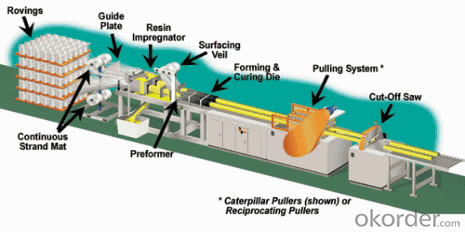
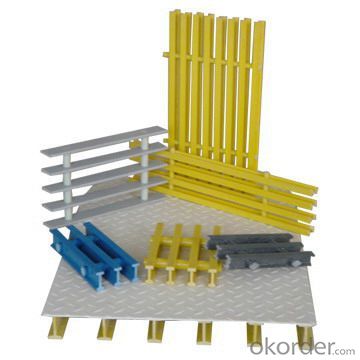
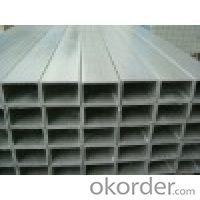
- Q: Can FRP pultrusion profiles be used in the construction of stadium seating?
- FRP pultrusion profiles offer a range of benefits that make them suitable for constructing stadium seating. Firstly, their lightweight yet strong composition is ideal for accommodating a large number of seats. This lightweight feature facilitates easier handling and installation, ultimately saving time and effort during construction. Secondly, FRP pultrusion profiles possess exceptional durability and corrosion resistance, making them well-suited for outdoor applications like stadium seating. Their ability to withstand rust, rot, and degradation from moisture, UV rays, and chemicals commonly found in stadiums ensures a long-lasting seating solution. Moreover, the non-conductive properties of FRP pultrusion profiles provide an added safety advantage, particularly in areas with electrical wiring. This reduces the risk of accidents or electric shocks associated with conductive materials. Additionally, the versatility of FRP pultrusion profiles allows for customization to meet specific design requirements, offering flexibility in stadium seating layouts. They can be manufactured in various shapes, sizes, and colors to align with both aesthetic and functional needs. Lastly, FRP pultrusion profiles boast a long service life with minimal maintenance requirements, resulting in a cost-effective choice for stadium seating in the long term. In conclusion, due to their lightweight, durable, non-conductive, customizable, and cost-effective nature, FRP pultrusion profiles are an excellent option for constructing stadium seating.
- Q: Can FRP pultrusion profiles be used in aerospace applications?
- Yes, FRP (Fiber Reinforced Polymer) pultrusion profiles can be used in aerospace applications. These profiles offer a combination of strength, lightweight, and corrosion resistance, making them suitable for various aerospace components such as structural supports, fairings, and interior panels. Additionally, FRP pultrusion profiles have high fatigue resistance and can withstand extreme temperatures, enhancing their suitability for aerospace use.
- Q: Are FRP pultrusion profiles resistant to oil and grease?
- FRP (Fiber Reinforced Plastic) pultrusion profiles are generally known for their excellent resistance to oil and grease. The combination of fibers, typically glass or carbon, with a polymer resin matrix results in a material that is inherently resistant to many chemicals, including oil and grease. This resistance is attributed to the non-reactive nature of the polymer resin, which prevents the oil or grease from penetrating the material and causing damage. Additionally, the pultrusion manufacturing process used to produce FRP profiles further enhances their resistance to oil and grease. During the pultrusion process, the fibers are impregnated with the resin and then pulled through a heated die, where the resin is cured. This creates a strong, uniform material with a dense surface that is less porous and more resistant to chemical penetration. It is important to note that the specific resistance of FRP pultrusion profiles to oil and grease can vary depending on the type of resin used and the specific application conditions. In some cases, specialized resin formulations can be used to further enhance the oil and grease resistance of FRP profiles, ensuring suitability for even more demanding environments. Overall, FRP pultrusion profiles are generally considered to be highly resistant to oil and grease, making them an excellent choice for applications where exposure to these substances is expected. However, it is always recommended to consult with the manufacturer or supplier to ensure that the specific FRP profile being used is appropriate for the intended application and chemical exposure.
- Q: What does M23 grade of glass fiber reinforced plastic section mean?
- There are many kinds of FRP Pultruded Shapes, such as glass fiber reinforced plastic round tube, glass fiber reinforced plastic square tube, glass fiber reinforced plastic rectangular tube, glass fiber reinforced plastic round bar, glass fiber reinforced plastic i-beam.
- Q: Are FRP pultrusion profiles resistant to electrical arcing?
- Generally, FRP pultrusion profiles exhibit resistance to electrical arcing due to their composition of non-conductive materials such as fiberglass reinforced plastic. By not conducting electricity, these profiles prove to be an optimal choice when concerns arise regarding electrical arcing and conductivity. Nevertheless, it is crucial to acknowledge that the extent of their resistance to electrical arcing may differ based on the unique composition and design of the FRP pultrusion profiles. Therefore, it is advisable to consult the manufacturer or supplier of the profiles to ensure they meet the specific electrical resistance standards required for a given application.
- Q: Are FRP pultrusion profiles resistant to chemicals used in pharmaceutical packaging?
- Yes, FRP pultrusion profiles are highly resistant to chemicals used in pharmaceutical packaging. The unique properties of fiberglass reinforced plastic, such as its corrosion resistance and non-reactivity to most chemicals, make FRP pultrusion profiles an ideal choice for pharmaceutical packaging applications.
- Q: Are FRP pultrusion profiles resistant to chemicals used in agricultural applications?
- FRP pultrusion profiles are known for their exceptional resistance to chemicals commonly found in agricultural settings. These profiles are composed of reinforced fibers and a polymer resin matrix, typically polyester or vinyl ester, which provide outstanding protection against a wide range of agricultural chemicals, including fertilizers, pesticides, herbicides, and acids. The inherent corrosion resistance of FRP pultrusion profiles makes them highly sought-after in agricultural applications where exposure to chemicals is prevalent. Unlike traditional materials like wood, steel, or concrete, these profiles do not deteriorate or degrade when exposed to aggressive chemicals. This resistance ensures that the profiles remain structurally sound and perform effectively throughout their long lifespan, even in harsh agricultural conditions. Additionally, FRP pultrusion profiles excel in their resistance to corrosion, moisture, UV radiation, and temperature fluctuations. This durability makes them ideal for a variety of agricultural applications, such as structural supports, fencing, grating, decking, and irrigation systems. However, it is important to note that while FRP pultrusion profiles are highly resistant to chemicals, they may still experience some level of degradation or staining when exposed to extremely concentrated or highly aggressive chemicals. To ensure compatibility with the chosen FRP pultrusion profiles, it is recommended to consult with the manufacturer or supplier regarding the specific chemicals used in the agricultural application.
- Q: Can FRP pultrusion profiles be used in electrical insulation applications?
- Yes, FRP pultrusion profiles can be used in electrical insulation applications. FRP (Fiber Reinforced Polymer) materials have excellent electrical insulation properties, making them suitable for a wide range of electrical applications. The pultrusion process ensures that the profiles have uniform insulation properties and high strength, making them ideal for use in electrical insulation applications.
- Q: Can FRP pultrusion profiles be used in the construction of agricultural structures?
- Yes, FRP (Fiber Reinforced Polymer) pultrusion profiles can be used in the construction of agricultural structures. FRP pultrusion profiles offer several advantages that make them suitable for agricultural applications. Firstly, FRP pultrusion profiles are lightweight yet strong, making them ideal for constructing agricultural structures such as greenhouses, barns, and storage facilities. Their high strength-to-weight ratio allows for easy installation and reduces the overall weight of the structure, thereby minimizing the need for heavy machinery during construction. Secondly, FRP pultrusion profiles are corrosion-resistant, which is a crucial characteristic for agricultural structures that are exposed to various environmental elements such as moisture, chemicals, and fertilizers. Unlike traditional materials like wood or steel, FRP does not rot, rust, or corrode, ensuring the longevity and durability of the agricultural structure. Additionally, FRP pultrusion profiles offer excellent electrical insulation properties. This is particularly beneficial in agricultural applications where electrical equipment, such as lighting systems or ventilation controls, are commonly used. The non-conductive nature of FRP prevents the risk of electrical shocks or short circuits. Moreover, FRP pultrusion profiles are highly customizable and can be designed to meet specific requirements. This flexibility allows for the creation of structures that are tailored to the unique needs of agricultural operations, such as load-bearing capacity, dimensional accuracy, and thermal insulation. Furthermore, FRP pultrusion profiles are non-magnetic, making them suitable for use in agricultural structures where magnetic interference can disrupt sensitive equipment or affect the growth of crops. Overall, the use of FRP pultrusion profiles in the construction of agricultural structures offers numerous benefits, including lightweight construction, corrosion resistance, electrical insulation, customization options, and non-magnetic properties. These advantages make FRP pultrusion profiles a viable and practical choice for agricultural applications.
- Q: Are FRP pultrusion profiles resistant to chemicals used in food processing?
- Yes, FRP (Fiber Reinforced Plastic) pultrusion profiles are highly resistant to chemicals used in food processing. They are specifically engineered to withstand harsh chemical environments, including the cleaning and sterilization agents commonly used in food processing facilities. This resistance makes FRP pultrusion profiles a suitable material choice for various applications in the food industry where chemical resistance is crucial.
Send your message to us
FRP Pultrusion Profiles - Fiberglass Gratings
- Loading Port:
- Shanghai
- Payment Terms:
- TT OR LC
- Min Order Qty:
- 50 m
- Supply Capability:
- 80000 m/month
OKorder Service Pledge
OKorder Financial Service
Similar products
Hot products
Hot Searches
Related keywords
